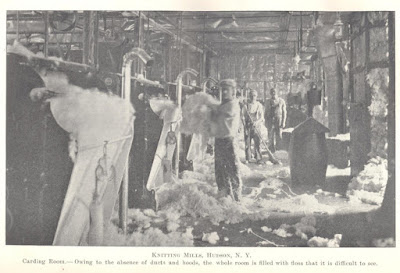 |
| Carding Room--Owing to the absence of ducts and hoods, the whole room is filled with floss [so] that it is difficult to see. |
 |
| Drying Room--This room is located in the cellar, and owing to inadequate ventilation the temperature ranges between 120 and 130 degrees |
 |
| Finishing Room--Shows overcrowded condition of workroom: the aisles are constantly blocked by huge piles of underwear in boxes, making escape in case of fire very difficult. |
 |
| The Finishing Room--Shows overcrowded condition: great boxes of finished goods obstruct the aisles of exits. |
This building, which stood on the southwest corner of Columbia and Second streets, burned in a spectacular fire in 1979, long after it ceased to be Union Mills. Providence Hall now stands on that site.
The caption accompanying the second photograph of a Finishing Room indicates it was on Washington Street, which means it was located in this building at the corner of Sixth and Washington streets, now known as the Pocketbook Factory.
COPYRIGHT 2016 CAROLE OSTERINK
Gratitude to Andrew Dolkart and Alan Neumann for passing the photographs from the Factory Investigating Commisssion report along to me.



The pictures make me sad. My grandmother immigrated to Hudson in 1898, at age 15, and a few days later started working in the Mills. 1900 census shows her working in the finishing room at the cotton mill.
ReplyDeleteI appreciate seeing the pictures from 1913, although by 1913 she was married with 2 sons and living in that lovely stone farm house on Leggett Rd in Omi. I wish more had been written about the lives of the young immigrant women who worked in factories.